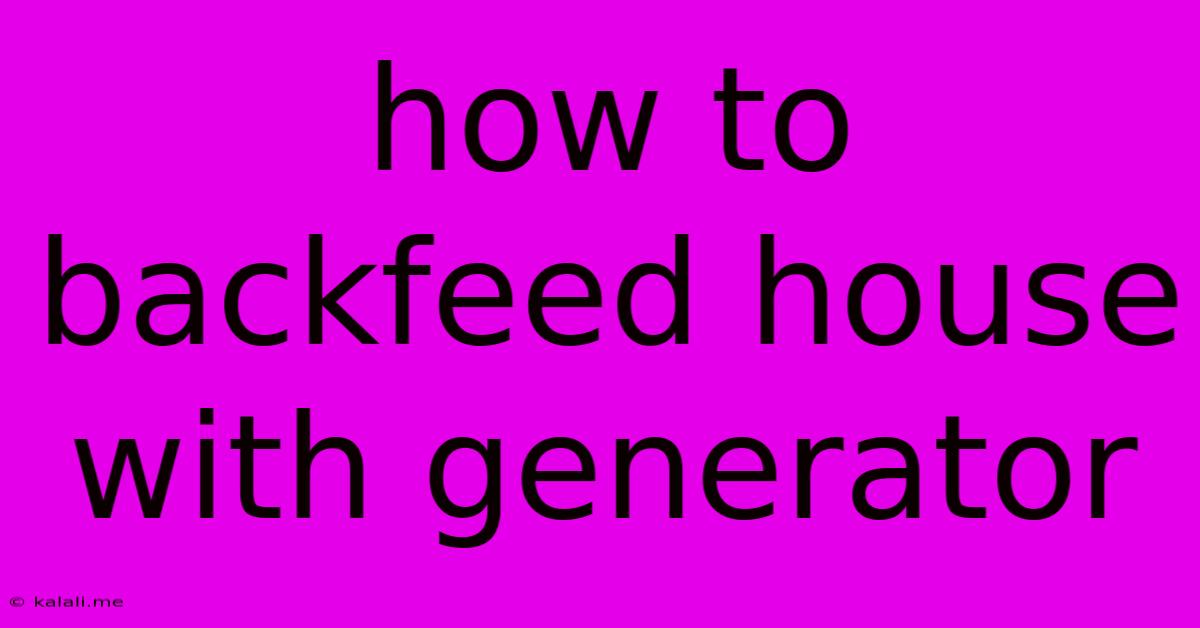How To Backfeed House With Generator
Kalali
May 25, 2025 · 3 min read

Table of Contents
How to Backfeed Your House with a Generator: A Comprehensive Guide
Meta Description: Learn how to safely and effectively backfeed your home with a generator during a power outage. This comprehensive guide covers different methods, safety precautions, and essential considerations for protecting your appliances and family.
Power outages can be disruptive and inconvenient, especially when you rely on electricity for essential needs like heating, cooling, refrigeration, and medical equipment. A home generator offers a reliable solution, providing backup power during outages. However, connecting a generator to your home's electrical system – a process known as backfeeding – requires careful planning and adherence to safety protocols. This guide will walk you through the process, explaining different methods and crucial safety measures.
Understanding Generator Backfeeding Methods
There are two primary methods for backfeeding your house with a generator:
1. Interlock System: This is the safest and most recommended method. An interlock system prevents accidental backfeeding into the power grid, protecting utility workers and your home's electrical system. It involves installing a transfer switch that disconnects your home from the power grid before connecting to the generator. This switch ensures that power from the generator doesn't flow back into the electrical lines supplying your neighborhood. Installation requires professional expertise from a qualified electrician.
2. Backfeeding through the Breaker Box (NOT RECOMMENDED): This method directly connects the generator to your main breaker box. While seemingly simpler, it's extremely dangerous and strongly discouraged. It bypasses critical safety features, risking electrocution for utility workers and damage to your equipment. This method should only be considered as a last resort in a true emergency situation and only if you possess extensive electrical knowledge.
Essential Safety Precautions When Backfeeding Your Home
Regardless of the method you choose, prioritizing safety is paramount:
- Professional Installation: For an interlock system, always hire a qualified and licensed electrician. Improper installation can lead to serious hazards.
- Carbon Monoxide Detection: Generators produce carbon monoxide, an invisible and deadly gas. Install carbon monoxide detectors inside your home and near the generator's operating location.
- Proper Ventilation: Operate the generator outdoors in a well-ventilated area, away from windows and doors. Exhaust fumes must be directed away from the house.
- Grounding: Ensure your generator is properly grounded to prevent electrical shocks.
- Circuit Breaker Protection: Only connect essential appliances and circuits to the generator. Avoid overloading the generator's capacity.
- Never Backfeed Directly into the Main Panel (Unless absolutely necessary and you have advanced electrical knowledge): This is the most dangerous aspect. It's crucial to use proper safety measures if you take this route. Incorrect connection can lead to serious injury or death.
- Turn Off Appliances Before Switching Power Sources: Avoid switching appliances between the grid and generator power without turning them off. This prevents sudden power surges and damage to sensitive electronic devices.
- Regular Maintenance: Schedule regular maintenance for your generator to ensure optimal performance and safety. This includes checking fuel levels, oil, and air filters.
Choosing the Right Generator for Your Needs
Generator selection depends on your home's power consumption. Consider the wattage requirements of essential appliances and devices to determine the appropriate generator size. Overestimating the required wattage is always preferable to underestimating. Factors to consider when selecting a generator include:
- Wattage: This determines the power output of the generator.
- Fuel Type: Gasoline, propane, and natural gas generators are commonly available.
- Run Time: How long the generator can operate on a single tank of fuel.
- Automatic Transfer Switch: This feature automatically switches power from the grid to the generator during an outage.
Conclusion
Backfeeding your house with a generator provides crucial backup power during outages. However, safety must always be the top priority. Choosing a safe installation method, such as an interlock system installed by a qualified electrician, is the most responsible approach. By following these guidelines and prioritizing safety, you can confidently rely on your generator during power interruptions. Remember, safety should always come first! Never attempt advanced electrical work unless you possess the necessary knowledge and expertise.
Latest Posts
Latest Posts
-
Text Embedding To Suggest Similar Words
May 25, 2025
-
Why Are My Villagers Not Breeding
May 25, 2025
-
Ask For Not Whom The Bell Tolls
May 25, 2025
-
Best Coffee Grinder For Pour Over
May 25, 2025
-
How To Insulate An Attic Roof Rafters
May 25, 2025
Related Post
Thank you for visiting our website which covers about How To Backfeed House With Generator . We hope the information provided has been useful to you. Feel free to contact us if you have any questions or need further assistance. See you next time and don't miss to bookmark.